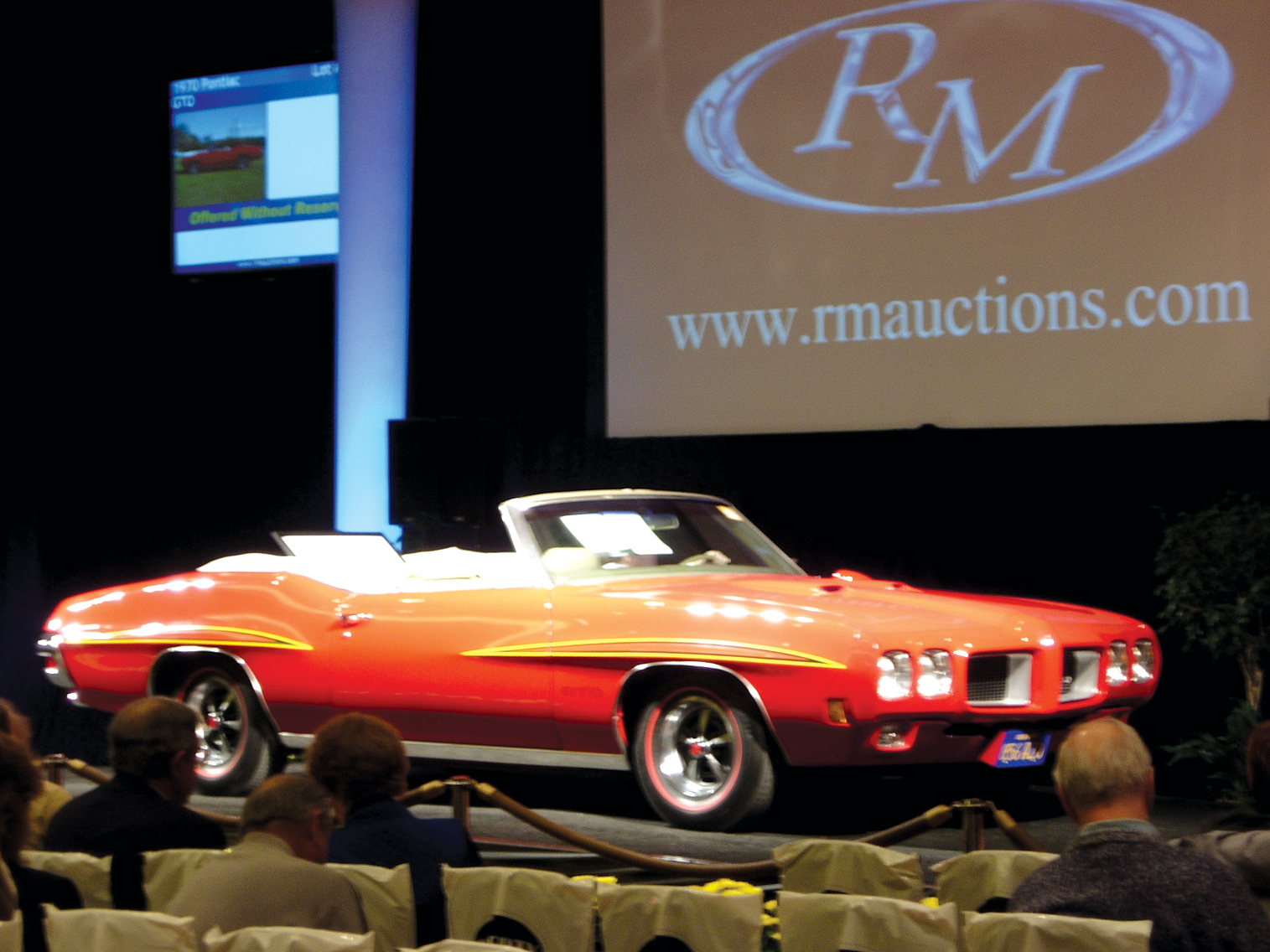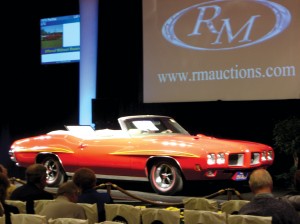By Brett Derosier
What comes in very bright colors, has a motor nicknamed the “elephant,” features a special Shaker hood scoop, a TorqueFlite automatic or four-speed manual transmission, and has appreciated in value over 50 percent in a single year? The 1970 Cuda with the famous 426 Hemi engine.
Muscle cars are on fire! This same 1970 Hemi Cuda in a convertible (maybe a dozen or fewer made) can demand as much as $1.5 million in today’s muscle car market. What about an Auburn Boattail Speedster or Cadillac V16? The classic cars are more like blue chip stocks and continue to move up at more of a conservative pace. The classic cars are some of the most beautiful in the world, such as Isotta Fraschini, Bugatti, Duesenberg, Auburn, Cord, Packard, Cadillac and more. One thing is for certain, special cars of any era will demand huge premiums. While the frenzy fueled the muscle car market, several “sleepers” went on the auction block for good prices. Sunday can sometimes be the best day to find a bargain at the auction because many people have left to go home, so the number of bidders usually decreases.
What is driving this market? It may be possible that we are seeing a change in the flow of capital from the older cars of the twenties, thirties and forties, into muscle cars. Could it be that the baby boomers are driving this market? Maybe. The baby boomers are at the top of the corporate ladder and making a significant amount of money as they reach retirement. They want the cars they grew up with or maybe that special automobile they couldn’t afford back then.
Maybe our friends from across the ocean have been taking advantage of the weak dollar. Pete Lansing, 1955 and 1957 Thunderbird owner and CEO of Universal Lending, says several Thunderbirds have been purchased on eBay and are headed to Europe. Another theory is that television is driving the hobby by attracting “new money.” In 1922, Babe Ruth signed a three-year contract with New York Yankees for a salary of 52,000 dollars a year (the highest salary for a ballplayer up to that time), meaning his pay equaled about 40 percent of the entire Yankee payroll. By 1927, The Babe was earning 70,000 dollars a year on his contract. Today, professional athletes have seen contracts for over $100 million because of this marketing and media-driven environment. Maybe the collector car market has been influenced by a little bit of everything.
Many of these automobiles have been called “rolling art.” We’ve seen some of the greatest designs and engineering placed into these drivable sculptures. The older cars were generally hand-built and wealthy owners had the opportunity to select a coachbuilder for their custom automobile body. Personal touches were found in some of these Pebble Beach Award-winning classics. Sometimes, the history is just as important as the automobile itself—if only the cars could talk.
The RM Auction, which took place at The Arizona Biltmore Resort & Spa on January 25, is where the distinguished, affluent and serious car collectors gather to bid on very rare automobiles. Bidders typically do their homework months in advance and know exactly what they’re buying. The RM Auction offered a multimillion dollar selection of nearly 100 significant collector cars.
The auction highlight was the Pebble Beach Award-winning 1933 Duesenberg Model SJ Riviera Phaeton, which sold for $2.75 million. Another very special car for the evening was a 1962 Aston Martin DB4GT “Zagato” in beautiful silver. Two very wealthy collectors challenged each other to bring the final bid to a close at $2.695 million. Bidding was strong for several rare Ferrari automobiles, including the 1972 Ferrari 365 GTB/4 Daytona Competizione N.A.R.T. Group 4 Competition Berlinetta specifically built for Luigi Chinetti’s North American Racing Team. Collectors had the rare opportunity to acquire one of the “Factory Five” alloy cars that raced on the world’s most famous speedways including Daytona, LeMans, Sebring and Watkins Glen.
At the 34th Annual Barrett-Jackson Classic Car Auction, which took place from January 25-30, at Westworld in Scottsdale, one would find a different setting. The buyers seemed a little different than those at RM and as a group they brought significant weight and purchasing power. Rather than the country club setting, Barrett-Jackson attracts the masses of automotive enthusiasts who travel to Scottsdale.
Most seem to be hard-working entrepreneurs or affluent coming to buy a Shelby GT500 KR, Pontiac GTO, Dodge Charger R/T, custom hot rod or maybe a 1967 Corvette Stingray 427/435. The most talked about automobile of the week was the 1954 Oldsmobile F-88 GM Concept Car. The XP-20 project, commonly known as F-88, was a project developed by Harley Earl, alongside Bill Mitchell, Ken Pickering and Zora Duntov. Four cars came out of the project and this is called the only “survivor” out of the factory. It made it into the hands of E.L. Cord, owner of Auburn-Cord-Duesenberg, in 1955.
It’s a fully-documented car with internal GM documents and the original blue prints. The Oldsmobile F-88 Concept Car sold for $3.24 million. Barrett-Jackson has done an incredible job of attracting the mainstream automobile collector and owner. Barrett-Jackson sold over $61 million in automobiles during the Scottsdale Auction 2005.

Brett M. Derosier, Co-Founder and Event Chair Morgan Adams Concours d’Elegance September 10, 1976 – August 13, 2005 Brett’s vision of a unique event; a carefully blended display of the best driving and flying machines in history, has come together through his incredibly hard work, his dedication and most of all, his belief in the purpose behind it all – a cure for children with cancer. We grieve the untimely loss of such an incredible partner and yet we celebrate his life, knowing that what he envisioned and loved will continue to grow, and in so doing, will honor his spirit.
Brett Derosier was a freelance writer for Airport Journals. Brett was a wonderful young man with a love of aviation, automobiles, and interesting people. Brett came into my office in June 2001 and introduced himself; he said, “I just had lunch at the Perfect Landing Restaurant where I picked up a Centennial Airport Journal. As I read it, it hit me that I need to write for this paper.” Brett had a quick smile and a solid hand shake. He explained that he just needed an opportunity to prove himself. He explained that as an asset management advisor, his best clients were residents of Centennial Airport. Brett said that his four best clients owned aircraft based at Centennial and that he often met with them at their hangars. The last time I spoke with Brett, he called me early one morning and told me he was making a quick trip to Sandpoint Idaho, to interview Dr. Forrest Bird. He said he was catching a ride with Stephen Gavit in his Cessna 425. The next evening, I got a call from Dr. Bird. He said, “Jerry, I have some very bad news. I just got a call that the flight that left here a couple hours ago with Brett onboard did not make it to Centennial.” By that time, Denver news was reporting a crash “on final approach” at Centennial. The local news had no names to release, but since the Sandpoint Airport was notified, we feared the worst. When the NTSB was trying to figure out who was in the left seat and some of the particulars, most of the answers came from a chip from Brett’s camera. Brett was taking photos from the time he climbed on board the Conquest and during the flight, until minutes before the crash. It was that reporter’s photos onboard that fateful flight that put many of the pieces together for the investigators. Brett acomplished a lot in those short 20 some years. He founded the annual “Morgan Adams Foundation Concourse d’Elegance” which celebrated it’s 11th year this year.
Joan Slaughter and Steven Adams started the Morgan Adams Foundation, with Brett Derosier, after their daughter succumbed to a brain tumor in 1998, when she was just 6 years old.
Committee chairs are Seve Hawthorne, Debbie Walters, Jeungmi Woo, Terry Dennett, Kelly Anton, John Milton, Sheri Sutton, Katherine Jacobson, Jim Waltersand Joe Thibodeau.
Guests included Peter and Marian Taylor; Mike and Connie Young; Deb Stoffel; Stephen Bell; Dorothy Holder; Bill Yeates and Gail Fawcett; Steve Winesett, president of the Children’s Hospital Foundation; foundation board chair Bradley Haight; Drs. Brian Winn, Nick Foreman, Michael Handler, Ralph Quinnones, Lia Gore, Rajeev Vibhakar, Lonnie Fallin and Arthur Liu; Mark Dismuke and Bill Stewart from Ferrari of Denver; Chuck Fabio of Beverage Distributors; Tom Kammerer of Chubb Insurance; Bill Nuccio of Lamborghini Denver; and Don Adis of Prestige Imports.
Denver Post Sept.14 2005
A twin-engine Cessna 425 crashed Saturday night in a field south of Centennial Airport while making a landing approach, killing all four people on board.
It was the fourth fatal crash near the Arapahoe County airport since December. After seeing flames from the latest accident, some nearby residents expressed unease.
The Cessna Conquest went down in an empty field about 4 miles south of Centennial runway 35 right, according to Parker fire officials.
The plane hit the ground, tumbled and then caught fire, said Parker Fire Chief Dan Qualman.
The crash site was 2 to 3 miles southeast of the Meadows at Meridian apartment complex, near South Peoria Street and Crescent Meadow Boulevard.
“These days, every time we see a plane fly over, we’re listening to their engines to make sure they’re working all right,” said Brian Meyers, 32, a Meadows resident.
There was some rain in the area at the time of the crash, about 8:20 p.m. But Parker fire spokeswoman Cheryl Poage said, “I wouldn’t say this would be the worst flying weather.”
The plane had traveled from Sandpoint, Idaho, and was on final approach to Centennial, said Federal Aviation Administration spokesman Mike Fergus.
The aircraft was registered to Sgavit Aviation of Littleton. The owner of Sgavit Aviation is listed as businessman Stephen Gavit of Littleton.













